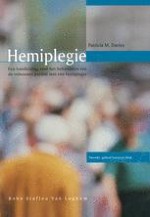Gepubliceerd in:
2001 | OriginalPaper | Hoofdstuk
9. Herleren van functioneel lopen
Abstract
‘Het vermogen om rechtop te lopen op twee benen speelt al meer dan drie miljoen jaar een sleutelrol in de levensstijl van het menselijk ras’ (Sagan 1979). Dit vermogen heeft het leven verruimd en de mens in staat gesteld talloze vaardigheden te verwerven die anders onbereikbaar waren gebleven. ‘Lopen is van alle menselijke bewegingen de meest voorkomende. Het is een van de meest complexe, volledig geïntegreerde bewegingen en toch wordt het vermoedelijk als de meest vanzelfsprekende beschouwd. Maar lopen gebeurt niet automatisch zoals ademhalen. Het moet worden aangeleerd’ (Winter 1988). Omdat mensen in de opgerichte houding een betrekkelijk klein draagvlak hebben, worden bij het lopen bijzonder complexe reacties vereist om het evenwicht te bewaren. Deze evenwichtsreacties zijn afhankelijk van houdingstonus en het vermogen om selectieve bewegingen uit te voeren, zoals beschreven in de hoofdstukken 2 en 3. Op basis van de resultaten van dierproeven is gesteld dat de basissynergieën voor de loopbeweging op ruggenmergniveau worden geproduceerd door zogenoemde centrale patroongeneratoren (cpg’s) (Brooks 1986; Grillner 1981; Smith 1980). Maar deze spinale generatorcircuits produceren wanneer ze worden gestimuleerd door tonische activiteit op zijn hoogst een slechte karikatuur van het lopen vanwege het ontbreken van belangrijke modulerende invloeden vanuit de hersenstam en het cerebellum (Shumway-Cook & Wollacott 1995). In werkelijkheid komen, zoals bij menselijke beweging in het algemeen het geval is, de bewegingen die noodzakelijk zijn om functioneel te lopen voort uit de interactie tussen meerdere processen, zowel zintuiglijke als motorische, evenals uit de interactie tussen de mens, de handeling en de omgeving. ‘Wat betreft het voortbewegen op twee benen kan het niveau van de synergieën wel de patronen in de extremiteit zelf en tussen beide extremiteiten opwekken, maar niet het daadwerkelijke, functioneel voortbewegen waarvoor voortdurende en doelmatige aanpassingen vereist zijn om te anticiperen op komende omstandigheden’, en ‘het vermogen op het niveau van de synergieën om de interne samenhang van een beweging te waarborgen staat lijnrecht tegenover het onvermogen om deze complexe en harmonieuze bewegingen te reguleren bij veranderingen in de omgeving’ (Turvey & Carello 1996). In het dagelijks leven worden bewegingen die behoren bij het lopen, voorgeschreven door plannen, intenties, de wens om een handeling uit te voeren of een probleem op te lossen en natuurlijk de noodzaak voor het aanpassen aan de omgeving en de voorwerpen die zich daarin bevinden. In de cyclus van elke pas worden de bewegingen precies afgestemd op de vereisten van de handeling (Grillner & Zangger 1979). Omdat het menselijk voortbewegen in wezen zo complex is en afhankelijk van vele hogere centra omvat het weer aanleren van het lopen veel meer dan alleen het stimuleren van de onderste extremiteiten of het versterken van de desbetreffende spieren. Het is gemakkelijk te begrijpen waarom sommige patiënten langdurige en intensieve behandeling nodig hebben om weer te leren lopen en waarom anderen, ook wanneer ze al snel weer op de been zijn, deskundige therapie nodig hebben om de manier waarop ze lopen te verbeteren. Ongeacht de problemen mag de duur en inspanning, benodigd om het best mogelijke resultaat te bereiken, niet worden beperkt.
